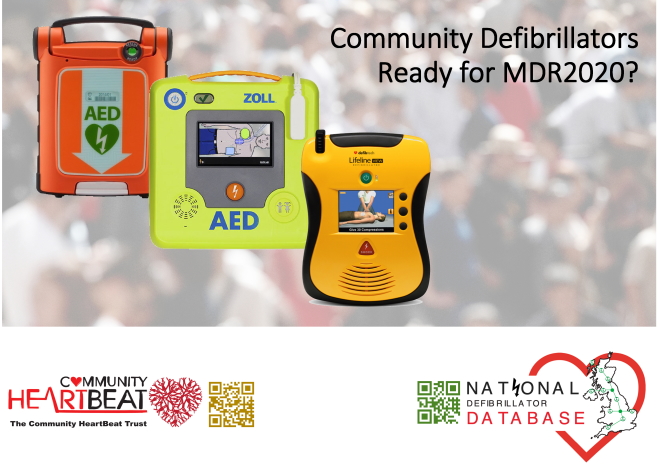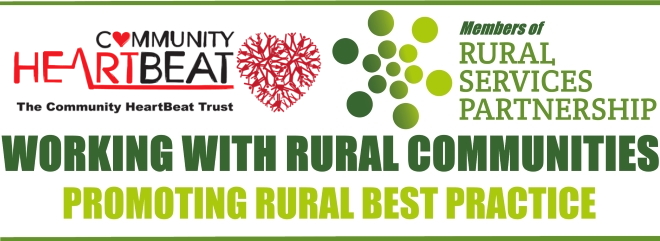T: 01822 851370 E: [email protected]
Visit RSN Survey about life in rural England to find out more.
Where are we going with Community Defibrillators?
Since 2008, numbers of defibrillators in the community has increased by several thousand. Many have been placed for altruistic reasons, but significant numbers of these defibrillators are now unloved and not looked after, wasting a valuable resource, as well as creating a poor service. Others are bought to a budget but may not have quality or longevity. Other projects are well undertaken and will serve many years. So where are we on this important area and how can rural communities ensure high quality projects?
Many community councils and parish councils work with the national charity, the Community Heartbeat Trust, to supply defibrillators, but to a high GSR standard, and encourage clubs to do the same. A defibrillator is a medical device used to help treat Sudden Cardiac Arrest (SCA), and comes under several regulations such as the Medical Devices Act, and from next year, the Medical Devices Regulations. In simple terms, these are devices that need Governance, Sustainability and Resilience to make sure they are kept in an operational way and rescue ready. Without GSR, a project is likely to fail. All defibrillator projects should be undertaken with GSR!
There are also many devices out there, but which are the best suited for community use? Whilst it is true any defibrillator will give a shock, it is unreasonable to expect an untrained member of the public to be conversant with how to use a defibrillator in a rescue, or for that matter to be expected to undertake Chest Compressions well. Thus, for a community project to be successful, it has to have the right equipment for the location and environment, as well as a resilient training and educational programme for the community.
As a charity, CHT tests all defibrillator equipment, and also cabinets, to ensure they meet minimum standards. CHT ask 54 questions of the defibrillators, and from this are able to advise the best suited defibrillators for the community. In general these are devices that are modern designs (ie technology that does not date back to 2000) and have feedback visually, usually via a visual display unit, for the end user giving detailed information, but in a calm and encouraging way. Many older devices assume the user is trained and will know the process, or fail to carry anything other than printed instructions. You cannot assume the user will speak English, particularly in Wales and some inner cities. So why use a defibrillator that only ‘talks’ to you? This would mean that you would be in breech of the Equalities Act 2010! Thus a good community device is one with a Visual Display unit, such as found on the Lifeline VIEW, Zoll AED 3, Mindray Beneheart, and other new devices, and will ‘talk’ modern protocols to the user.
Heath and Safety signage regulations also suggest that any first aid site, including defibrillator sites, should have internationally recognised signage, at the specific location and also at two other locations nearby directing users to the site. The internationally recognised signage is the heart with a lightning flash through. In the UK and Europe this is the ILCOR signage. To use any other signage is not only against H&S guidance, but also fails to meet British Standards for signage. Hence other signage that shows, for example, a ‘handbag and squiggle’ and calls the defibrillator (incorrectly) a ‘heart restarter’ is actually misleading. If someone failed to identify a defibrillator placement from unrecognised signage, and this delay led to a failed rescue, what would our position be in respect to the coroner? Far better to use internationally recognised signage, and avoid issues, particularly in tourist areas. The same applies for other signage such as road signs, and safety signs. Why use non-standard signage and create issues? It is important for communities to be offering high class and correct services to communities.
Community awareness programmes are essential. This does not mean just a CPR/AED training session. It is more than this. Several suppliers offer ‘training’ but limit this to just 12 people in your community, or fail to address all the aspects of ‘training’ needed to ensure competency and confidence in a community. These are ‘awareness sessions’ and not ‘training sessions’ as this is not to generate a nation of paramedics, but it is about confidence of how to help in an emergency and how to save a life. In addition the community should plan a resilience programme in the community to encourage additional first aid sessions, as well as a series of posters and handouts to all houses. Some villages may also benefit from local volunteer teams to help in a rescue, particularly if there is no CFR group nearby (under 5 minutes). With CHT, we have designed a series of resources for communities to use.
Sustainability is about planning for the ongoing costs to the community to ensure your equipment has a life beyond the first 2 years. This is very important for every community, as we want these projects to last a lifetime, not just for Christmas. Many resellers will advise that you only need to budget for replacement pads and batteries every 2 years or so, which is true if the device is never used. However the real cost to support a device in the community is £125 to £175 per annum, dependent upon equipment, as it is not just consumables to be considered. What about insurances? What about replacement equipment when yours goes missing? What about ‘seek and find’ costs? What about electrical safety checks on the cabinets if mains powered? All these add costs to your cPAD site, and should be budgeted for. With over 5000 sites, CHT are well aware of the real costs by device and location, and advise people accordingly. The real cost should be looked at over at least 10 years. This will show whilst some ‘expensive and modern’ equipment may be costlier in the short term, over the life of the equipment it will be more cost effective and resilient, and have features that save lives.
Some resellers wrongly advise about insurances, and fail to notify the users their onus under public liability, duty of care, and other areas. Clinical liability is already addressed, so no need to worry about this.
If a community group has funded or bought the defibrillator, then they may be classed in law as the ‘owners’. The ‘owner’ has a duty to maintain Governance about the defibrillator site, along with ‘duty of care’ to the community where it is positioned. With the introduction of the MDR regulations in May 2020, this now becomes a legal requirement, not a nice to have. The ‘owner’ has these legal duties. Websites that just ask you to supply weekly/monthly/quarterly checks are not governance. MDR asks records are kept ‘in line with the manufacturer’s recommendations’, and ‘for the life of the device’, and a good governance system will track the full provenance of the equipment, and have this available to all stakeholders and the coroner if required. Some reporting sites require you to sign away your rights to your data, and the data you provide may be used for commercial reasons, without your agreement. They may also be going behind your back asking others to register and agree to terms about your site, without your knowledge. The WebNos Governance system is free and guaranteed not to be used for commercial or other reasons and do not sign away your rights. WebNos also feeds the National Defibrillator Database automatically. WebNos also allows stakeholders to manage and financially control funds and to make sure the cPAD projects are being looked after and continue to give sustainability to the project. Any sites already installed can be added to WebNos, whether or not bought via CHT. It is a free service.
The Resuscitation Council UK advises that all communities should consider having ‘teams of trained individuals that can help in an emergency’. These do not need to be community responder groups, but volunteers who have basic life support training that can fetch the defibrillator, help with chest compressions or just provide TLC. Under the CHT system these are called VETS volunteers and are linked by a single telephone number that can be used to summon helps. VETS systems are also used for care of the elderly as well as neighbourhood watch, as well.
Any project should be undertaken with experienced and knowledgeable suppliers, and not those just advertising equipment at cheap prices, or the internet. This is about lives, not money, politics, or just ‘tick the box’. Believe in GSR, and put this at the heart of your community defibrillator project !





